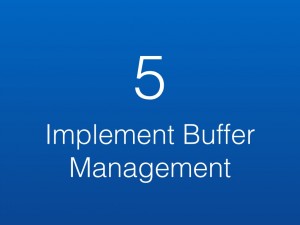The fact that the constraint must function 100% of the time means this phase is highly critical, and the intrinsic variation in every real system makes scheduling a random process. This is the reason why the constraint must be protected by an adequate buffer. Given that we must always guarantee that at every moment the constraint has material to process, we must make sure there is always enough material in front of the constraint. We achieve this by creating a buffer which is sized on the basis of the consumption of the constraint and the transfer time from the previous phase to the constraint.
One minute lost on the constraint is cash that the system will never get back.
In order to prevent disruptions on the constraint AND at the same time have a firm grasp of how the rest of the system is performing, we need to institute a protection and control mechanism on the constraint, something that prevents the cumulated variability of the processes (breakdowns, snags, rework, strikes, etc.) to harm the constraint.
We call this protection “Buffer” (a quantity of time we allow to exist in front of the chosen constraint – how much time in advance the batch to be processed by the constraint has to get there) and “Buffer Management” the Plan-Do-Study-Act cycle we trigger by measuring the statistical fluctuations that affect the Buffer.





